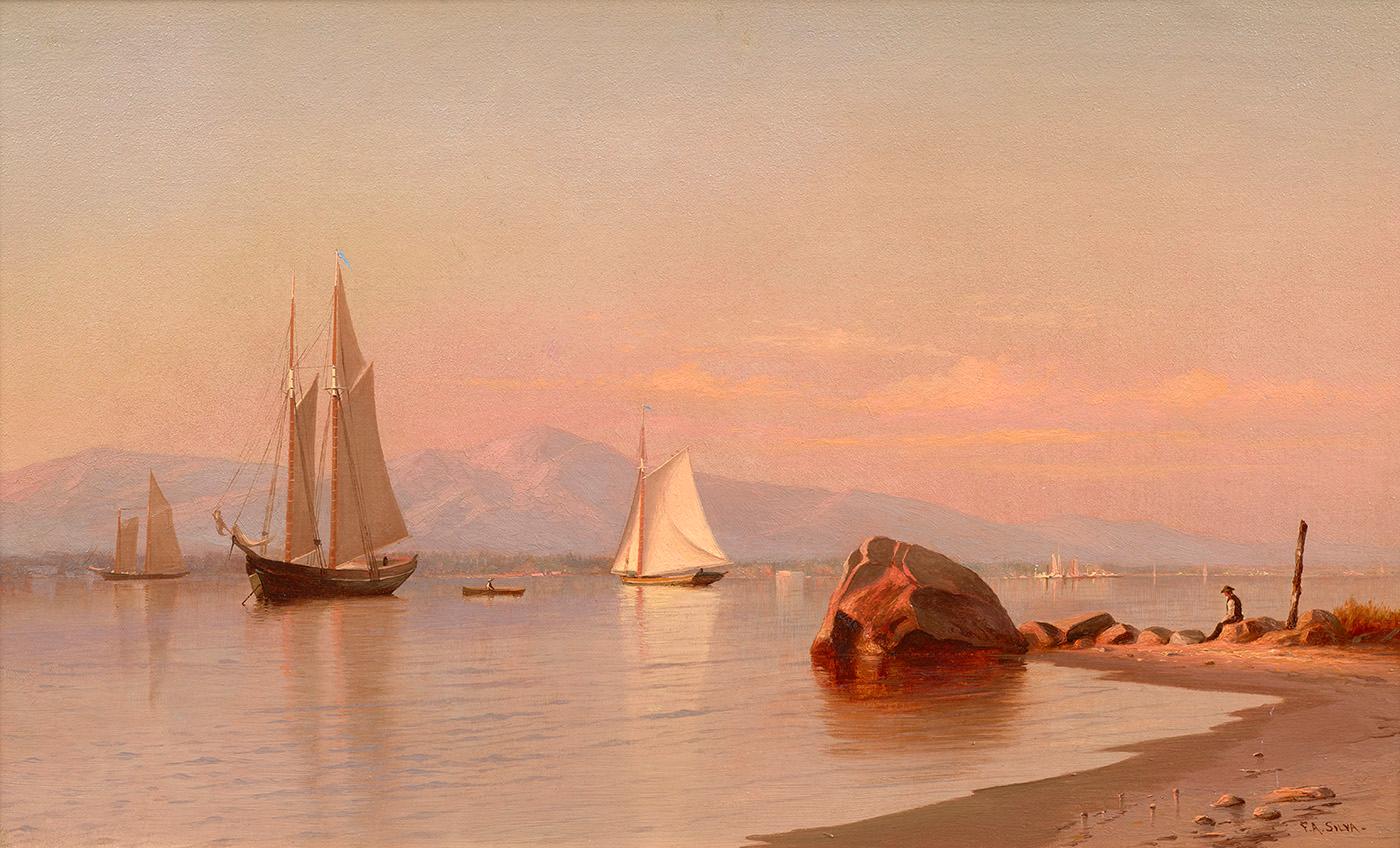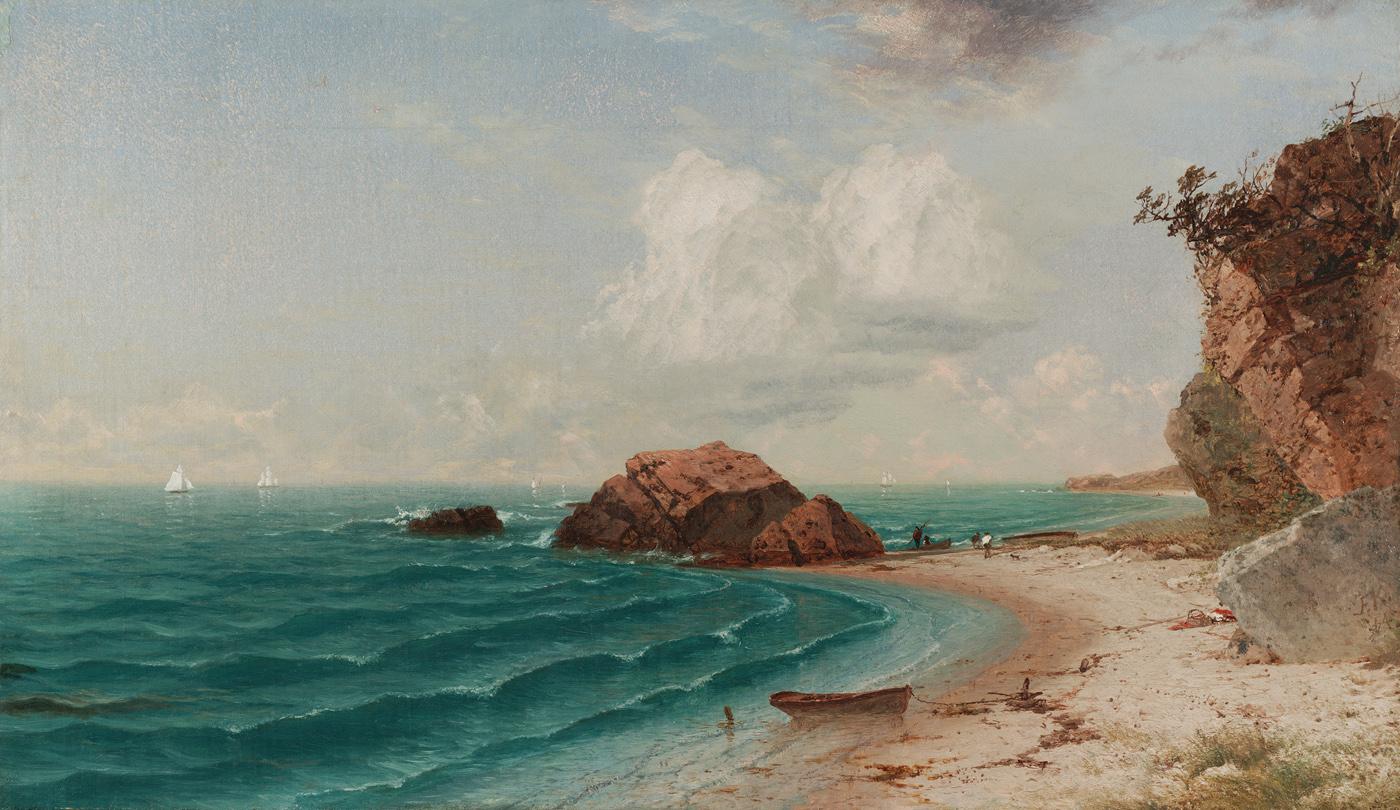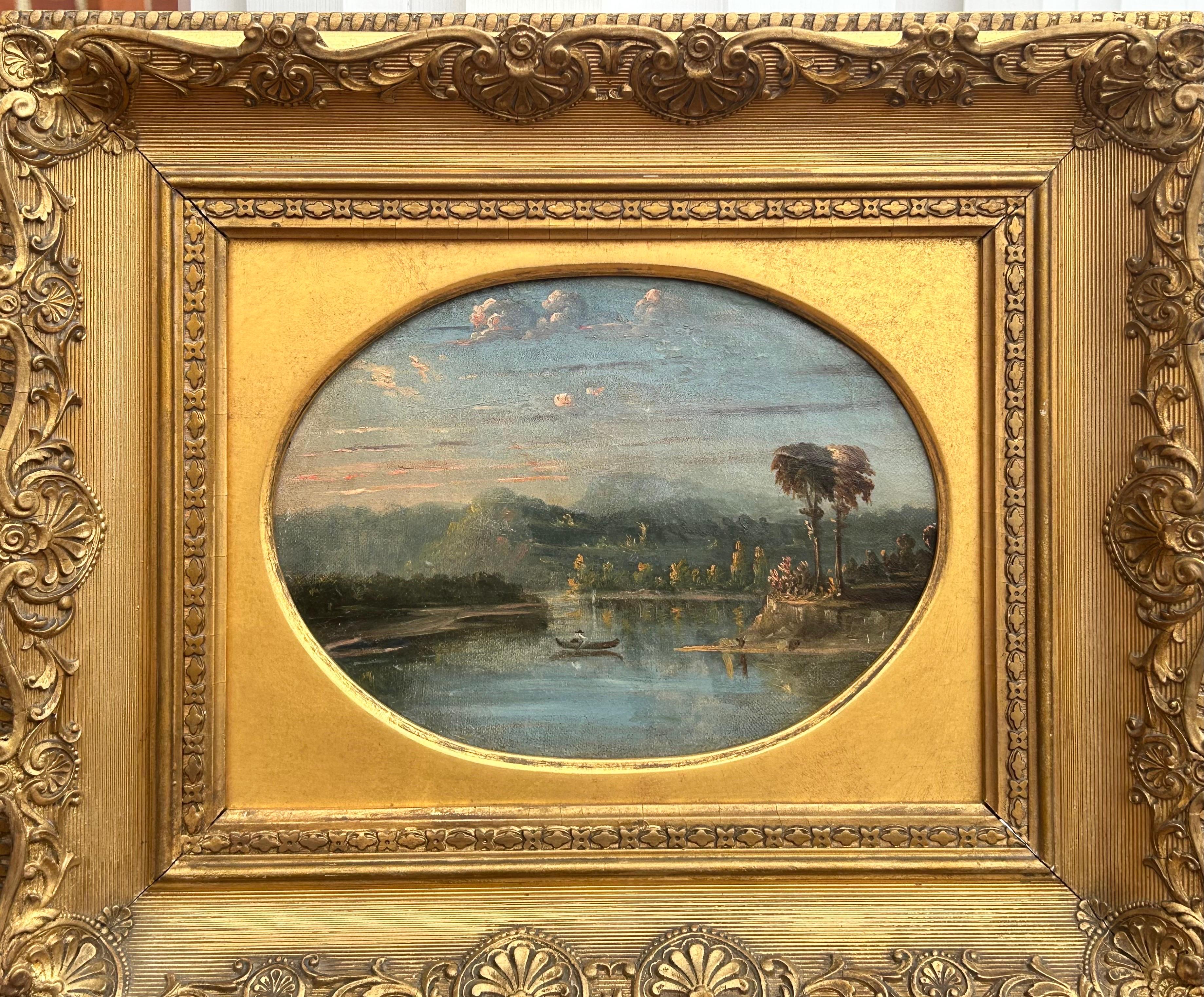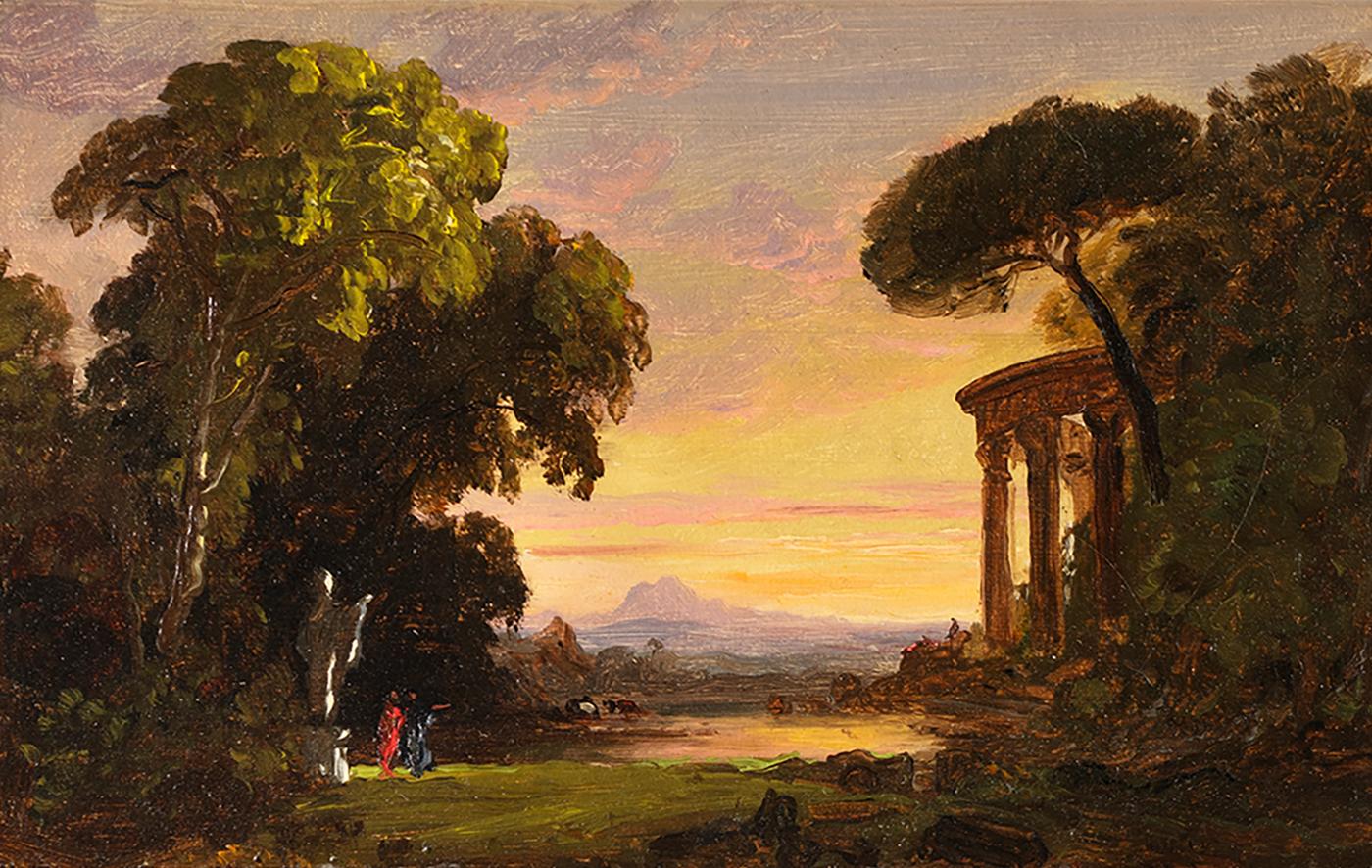Items Similar to "Ship Portrait, " William Edward Norton, Seascape Maritime Painting, New England
Want more images or videos?
Request additional images or videos from the seller
1 of 9
William Edward Norton"Ship Portrait, " William Edward Norton, Seascape Maritime Painting, New England1876
1876
About the Item
William Edward Norton (1843 - 1916)
Ship Portrait, 1876
Oil on canvas
10 x 16 inches
Signed and dated lower left
Born in Boston, William Norton became a noted marine painter, stirred by his youth when he sailed on family-owned ships. He studied at the Lowell Institute in Boston, and with George Inness, and then established a studio in Boston.
In the early 1870s, he went to Paris and became a student with Chevreuse and A. Vollon, and then he settled in London where he exhibited throughout the last quarter of the 19th century. His reputation there was based on his scenes of the Thames River, and ocean and coastal views.
In 1901, he and his wife returned to the United States and settled in New York City. He also painted at Monhegan Island, Maine, where a treacherous ledge on the southern side of the island is named "Norton's Ledge" for him.
He was a member of the Boston Art Club with whom he exhibited from 1873 to 1909. He also exhibited with the Pennsylvania Academy, the Royal Academy in London, the Paris Salon, the 1893 Chicago Exposition, and the Art Institute of Chicago.
- Creator:William Edward Norton (1843 - 1916, American)
- Creation Year:1876
- Dimensions:Height: 17 in (43.18 cm)Width: 23 in (58.42 cm)
- Medium:
- Movement & Style:
- Period:
- Condition:
- Gallery Location:New York, NY
- Reference Number:1stDibs: LU1841210534322
William Edward Norton
Born in Boston, William Norton became a noted marine painter, stirred by his youth when he sailed on family-owned ships. He studied at the Lowell Institute in Boston, and with George Inness, and then established a studio in Boston. In the early 1870s, he went to Paris and became a student with Chevreuse and A. Vollon, and then he settled in London where he exhibited throughout the last quarter of the 19th century. His reputation there was based on his scenes of the Thames River, and ocean and coastal views. In 1901, he and his wife returned to the United States and settled in New York City. He also painted at Monhegan Island, Maine, where a treacherous ledge on the southern side of the island is named "Norton's Ledge" for him. He was a member of the Boston Art Club with whom he exhibited from 1873 to 1909. He also exhibited with the Pennsylvania Academy, the Royal Academy in London, the Paris Salon, the 1893 Chicago Exposition, and the Art Institute of Chicago.
About the Seller
5.0
Platinum Seller
These expertly vetted sellers are 1stDibs' most experienced sellers and are rated highest by our customers.
Established in 2021
1stDibs seller since 2022
61 sales on 1stDibs
Typical response time: 1 hour
- ShippingRetrieving quote...Ships From: Larchmont, NY
- Return PolicyA return for this item may be initiated within 3 days of delivery.
More From This SellerView All
- Rapelyea House, New York, William Rickarby Miller, Hudson River School LandscapeBy William Rickarby MillerLocated in New York, NYWilliam Rickarby Miller Rapelyea House, New York, 1884 Signed and dated lower left Oil on canvas 20 x 30 inches Provenance: Kennedy Galleries, New York Born in Staindrop, County Du...Category
1880s Hudson River School Landscape Paintings
MaterialsCanvas, Oil
- "Hubbard Park, Crescent City, Florida" George Frederick Morse, LandscapeLocated in New York, NYGeorge Frederick Morse Hubbard Park, Crescent City, Florida, 1906 Oil on canvas 17 x 12 inches A landscape and marine painter from Portland, Maine, George Morse was a founding membe...Category
Early 1900s Hudson River School Landscape Paintings
MaterialsCanvas, Oil
- "Couple in the Field, " James Brade Sword, Hunter on Farm LandscapeBy James Brade SwordLocated in New York, NYJames Brade Sword (1839 - 1915) Couple in the Field Oil on canvas 16 x 20 inches Signed lower left After a childhood in Macao, China, James Brade Sword started out in life, after hi...Category
Late 19th Century Hudson River School Landscape Paintings
MaterialsOil, Canvas
- "Pastoral Landscape, " William Hart, Hudson River School, Cloudy View with CowsBy William HartLocated in New York, NYWilliam Hart (1823 - 1894) Pastoral Landscape, 1877 Oil on canvas 9 1/2 x 14 1/2 inches Signed and dated lower left Born in Paisley, Scotland, William Ha...Category
1870s Hudson River School Landscape Paintings
MaterialsOil, Canvas
- "Building the Allegheny Railroad, Pennsylvania" Alfred Wall, Scalp Level SchoolLocated in New York, NYAlfred S. Wall (American, 1825-1896) Untitled (Building the Railroad), 1859 Oil on canvas 14 1/2 x 18 1/2 inches Signed and dated lower left For Christmas, 2008, the Pittsburgh Post-Gazette featured Alfred Wall's painting, Old Saw Mill from the collection of the Westmoreland Museum of American Art in Greensburg, PA. It was painted in 1851 in the town of Lilly, Pennsylvania in the Allegheny Mountains. The newspaper description stated that "though the saw mill is long gone, it still conveys all the warmth and coziness of this time of year. The article, written by Patricia Lowry, continued: At first glance, Alfred S. Wall's painting of a saw mill in snowy woods triggers nostalgia for the coziness of a log cabin, the smell of a wood-burning fire and the warming of chilled hands and feet beside it. But as sentimental as it seems on the surface, Mr. Wall's painting has a deeper and unexpected context. This is more than a painting about sled-riding children and early industry planted in the middle of virgin forest. Intended or not, this is a painting about conquering the great divide of the Allegheny Mountains. For the third consecutive year, the Post-Gazette features a winter-scene painting on the cover of the Christmas Day newspaper. This year's painting, Old Saw Mill, was selected by co-publisher and editor-in-chief John Robinson Block and executive editor David Shribman during a visit to the Westmoreland Museum of American Art in Greensburg. Mr. Wall, listed as a portrait painter in the 1850 census, was about 26 when he painted Old Saw Mill in 1851. The self-taught artist was born in Mount Pleasant, Westmoreland County, to William and Lucy Wall, who'd emigrated from England around 1820. An artistic sensibility ran in the family: William was a sculptor who carved ornate tombstones here; Alfred's children, A. Bryan and Bessie, were landscape painters, as was Alfred's older brother, William Coventry Wall. For more than a century the Walls formed a prominent art dynasty in Pittsburgh, and Alfred, eventually a partner in the city's most prestigious art gallery, was well known as a painter, dealer and restorer. In Old Saw Mill, two wood cutters, each holding an axe, meet outside the mill; one points in the direction of the forest. On the other side of the stream, one child pulls another down the hillside on a sled. Just behind the hill's slope, the roof of a building appears, perhaps the home of the sawyer. The luminous, late afternoon light comes from the northwest, casting lengthening shadows on the snow under a darkening sky. The saw mill in "Old Saw Mill" likely would have been impossible to track down had Mr. Wall, presumably, not written on the back of the painting: "old saw mill near Jct. 4, Portage RR, Pa." "There was no Junction 4," said Mike Garcia, park ranger at the Allegheny Portage Railroad National Historic Site, about 90 miles east of Pittsburgh near Gallitzen, Cambria County. "But there was an Inclined Plane No. 4 at Lilly, and there was a saw mill there." In fact, there were at least six saw mills at Lilly over the years, said longtime resident Jim Salony, president of the Lilly-Washington Historical Society. But when he saw an image of the painting, Mr. Salony had no trouble coming up with a location. While there are no known photographs of the saw mill, he believes it stood near the intersection of Portage and Washington streets, next to Bear Rock Run. Mr. Salony, retired academic dean at Mount Aloysius College, didn't know exactly when the mill was torn down, but it's been gone since at least the late 1800s. He was pleased to learn of the painting, even though that knowledge came too late for inclusion in a new book about Lilly, The Spirit of a Community, for which he served as primary author and editor. It runs to more than 700 pages. For a little town -- population 869 last year -- Lilly has a lot of history. Nestled in a bowl on the western slope of the Allegheny Mountains about 3 miles south of Cresson, Lilly was first settled in 1806 by Joseph Meyer and his family, who named their 332-acre land patent Dundee. Although the Meyers had left by 1811, other settlers followed, but the community didn't flourish until the 1830s, when the Allegheny Portage Railroad began its 23-year-run through the town. For 200 years the Alleghenies had stood as an impediment to trade and travel between Pittsburgh and the east. A canal from Philadelphia to Pittsburgh would change that and compete with New York's Erie Canal. But a portage railroad would have to be built, on which teams of horses would lead the canal boats over the mountains. Engineer Sylvester Welch began his surveying from the small settlement at Lilly. The railroad would require 10 inclined planes, some quite steep, between Hollidaysburg and Johnstown. To build it, trees had to be cut along a 120-foot-wide right-of-way for 36 miles, along which track and engine houses had to be built. William Brown, who owned the saw mill on Bear Rock Run, built at least one of the engine houses at Inclined Plane No. 4; an 1834 contract also included fencing the dwelling lots at the head and foot of the plane. Lilly is located at what was the foot of Inclined Plane No. 4., giving the community one of its early informal names, Foot of Four. Named in 1883 for Richard Lilly, who'd completed the grist mill there, Lilly had another early name: Hemlock, so dubbed by a Portage Railroad traveler who smelled the bark stripped from the trees at the saw mill. Because there isn't another Allegheny Portage Railroad location like it, where a cut in the mountains opens into a bowl, Mr. Salony thinks it was Lilly that Charles Dickens wrote about following his trip from Harrisburg to Pittsburgh on the Pennsylvania Canal in late March 1842, describing what he saw after emerging from "the bottom of the cut": "It was very pretty while traveling, to look down into a valley full of light and softness, catching glimpses through the tree-tops of scattered cabins; children running to the doors; dogs bursting out to bark, who we could see without hearing; terrified pigs scampering homeward; families sitting out in their rude gardens; cows gazing upward with a stupid indifference; men in their shirt-sleeves looking on at their unfinished houses, planning out to-morrow's work; and we riding onward, high above them, like a whirlwind." To get to Lilly, Mr. Wall may have taken the Pennsylvania Canal from his home in Allegheny City, now the North Side. He'd married young, at 21, to Sarah Carr in 1846, the same year he began his career as an artist. By 1880 they were living in a brick townhouse at 104 (later 814) Arch St., now demolished. Across the river in Pittsburgh he shared a studio at 67 Fourth Ave. with his brother William; they later moved to Burke's Building, today the city's oldest office building at 209-211 Fourth. But often they worked outdoors, sometimes as part of the colony of artists that grew up around painter George Hetzel beginning in the late 1860s at Scalp Level...Category
1850s Hudson River School Landscape Paintings
MaterialsOil, Canvas
- "Western Lake Landscape, " John Fery, Hudson River School ViewBy John FeryLocated in New York, NYJohn Fery (1859 - 1934) Western Lake Landscape, circa 1920 Oil on canvas 21 x 23 1/4 inches Signed lower left Provenance: Private Collection, New York Born in Austria, John Fery earned a strong reputation for dramatic paintings of western mountain landscape in the United States. Glacier National Park in northwest Montana was a popular subject for him. He was raised in a prominent, wealthy family that lived on an estate about nineteen miles northeast of Salzburg. His mother was Hungarian, and his father was born in Bohemia. S ome sources have written that he studied art in Dusseldorf, Germany with Peter Jansen, and also in Munich, Venice and Karlsruhe. But his "name does not appear in the records of the major art schools in any of these places, nor is there any record of his name at either the Vienna or Budapest academies." (Merrill 26) It is possible, however, that he received private instruction, and because of the sophistication of his painting, sources think it unlikely that he was self taught. An early interest in wilderness scenery led him to painting American landscapes and hunting scenes. In the mid 1880s, he came to America and lived in the German community in Milwaukee, and then in 1886, brought his family to the United States. His wife, Mary Rose Kraemer (1862-1940), was born in Switzerland, and they had one child born near Munich and two others born in the United States. From 1886 to 1888, they lived in New York, and by 1890, Fery had made his first trip West. He visited Yellowstone Park in 1891, and indicated in his writings that he had been there even earlier. From 1892 to 1893, he led European nobility on hunting expeditions to the American Northwest, made possible by the completion of the Northern Pacific Railroad...Category
1920s Hudson River School Landscape Paintings
MaterialsCanvas, Oil
You May Also Like
- Niagara Falls with View of Clifton HouseBy Jasper Francis CropseyLocated in New York, NYSigned and dated right of center: J.F. Cropsey / 1852Category
Mid-19th Century Hudson River School Landscape Paintings
MaterialsCanvas, Oil
- View on the Hudson, the Catskills in the DistanceBy Francis Augustus SilvaLocated in New York, NYSigned lower right: F.A. SILVA.Category
Late 19th Century Hudson River School Landscape Paintings
MaterialsOil, Canvas
- Into the NightBy Ralph Albert BlakelockLocated in New York, NYSigned lower left in arrowhead: RA Blakelock.Category
Late 19th Century Hudson River School Landscape Paintings
MaterialsCanvas, Oil
- New England Coastal Scene with FiguresBy John Frederick KensettLocated in New York, NYMonogramed and dated lower right: JF.K. / ‘64.Category
Mid-19th Century Hudson River School Landscape Paintings
MaterialsCanvas, Oil
- Southern Landscape Oil Painting Hudson River SchoolLocated in Fredericksburg, VACopyright 2023 Michael F. Meyer All rights Reserved. This painting, signed RSD on right side, has been verified by the late expert on Robert S. Duncanson, Joseph Ketner and comes with an authentication letter. This painting has exhibited and is published in Robert S. Duncanson and His Courageous Southern Travels. This painting is one of the many beautiful southern landscape scenes that Robert S. Duncanson painted in his courageous travels south. "Robert S. Duncanson born in 1819, was an African American Hudson River School artist who painted the south before the Civil War, until his death in 1872. Although widely famous during his lifetime, this forgotten artist’s courageous journey through the antebellum south has never before been exhibited or researched until now. His brilliance was in creating captivating landscape paintings that come alive to the viewer, by focusing on the minute details of nature and of the stories he wished to communicate. Robert Duncanson...Category
Mid-19th Century Hudson River School Landscape Paintings
MaterialsOil, Canvas
- Ruins with FiguresBy Jasper Francis CropseyLocated in New York, NYFamed Hudson River School painter and architect.Category
19th Century Hudson River School Landscape Paintings
MaterialsPaper, Canvas, Oil
Recently Viewed
View AllMore Ways To Browse
London Ship
Painting Of London England
New England 19th Century
New England Landscape
Landscapes Of New England
New River Painting
New England Oil
New England Oil Paintings
Landscape Painting New England
Ship Oil Painting Framed
Landscape Painting And New England
Edward View
Southern School
Pennsylvania School Painting
Oil Painting New England Landscape
19th Century Paintings Of New York
New England Landscape Oil
New England Art Scenes






